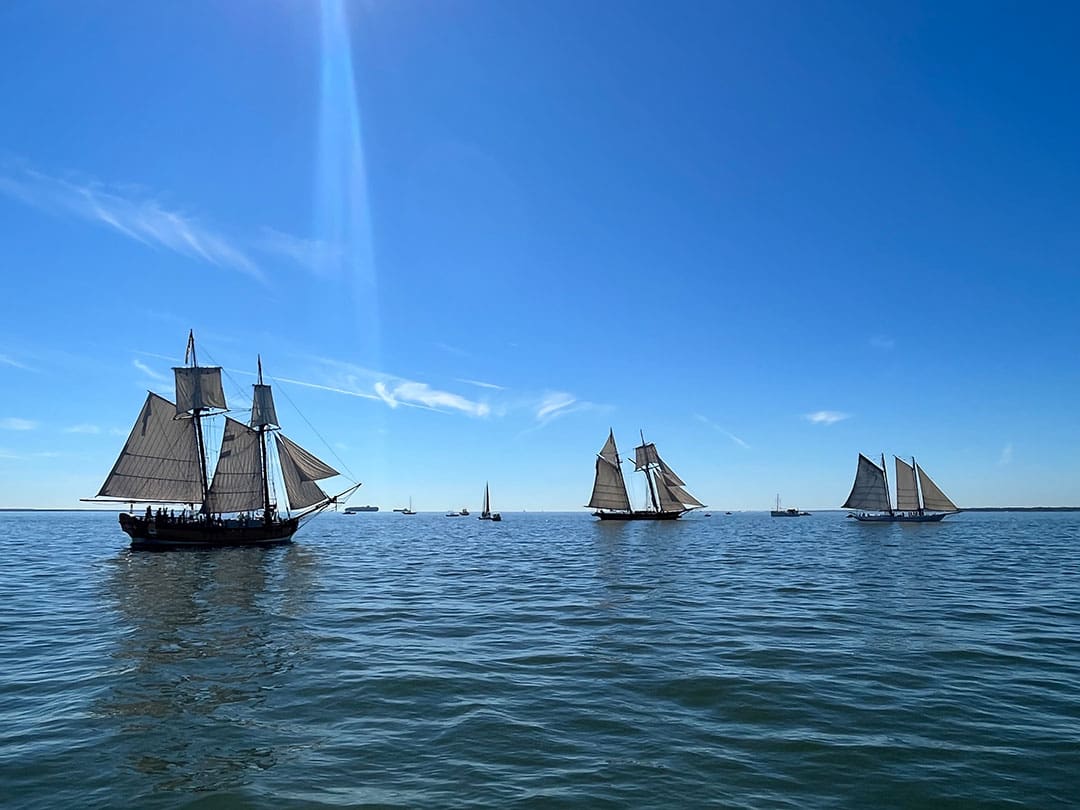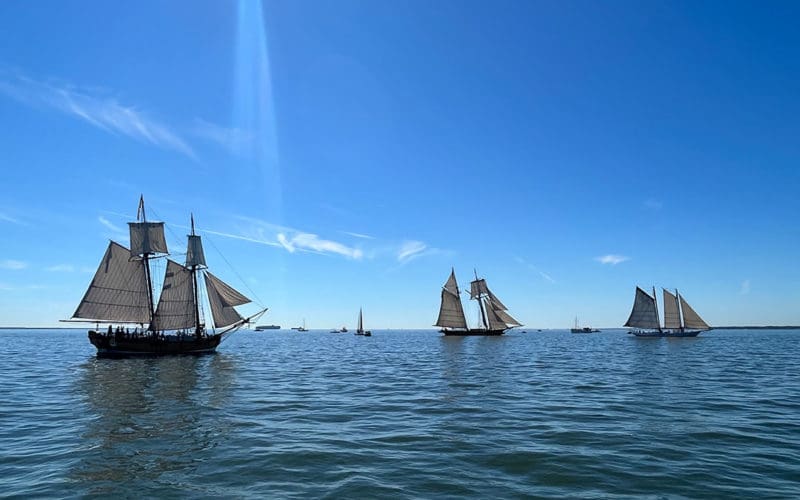
by Rob Laymon
Strong winds and cold rain, the sailor’s delight. Four days of it came from a nor’easter spawned by Hurricane Ian, jumbling the plans for the Great Chesapeake Bay Schooner Race, held October 6 through 8. This annual event attracts schooners of all sizes to race in four classes between Annapolis and Norfolk. I sailed aboard Prom Queen, a 50-foot Campanella owned by Roger Worthington, an intermittent participant and a past winner of the race.
In this year’s race, the schooner Virginia, the current record holder, had made it as far as Smith Point before turning back to Norfolk, unable to make headway because of engine trouble. Others of the big schooners — A.J. Meerwald, Pride of Baltimore II, Sultana — took their places in the starting lineup. Usually the schooners converge in Baltimore on the day before the start, but this year, facing the piercing north wind, many waited until Thursday, the day of the race’s start, and simply showed up at the starting line off Annapolis. On that day, the forecasts insisted, clement weather would return. Little orange suns appeared in all the relevant Thursday weather columns.
And so it happened. Thursday came bright and warm and a gentle southerly succeeded the grim north wind, strong enough for the numerous boats of the race to swan about handsomely in the waters south of the Bay Bridge, but not strong enough to provide the lively terror of racing speed. Nor was the direction right. When the starting horn finally sounded, 19 schooners and schooners-by-decree set off at such an oblique to the rhumb line they might get back to Annapolis or the Chick-fil-A in Easton, but not the 140 miles south to Norfolk, not in anything like the 20 or so hours it takes on average.
The Great Chesapeake Schooner Race came into being in 1988 when Captain Lane Briggs, creator of the Tugantine Norfolk Rebel — so far as anyone knows the only sail-assisted schooner-rigged tugboat in the world — challenged Pride of Baltimore II to race from Baltimore to Norfolk. By 1990 the race was an annual event, drawing as many as 56 schooners and vessels from as far away as California.
The theory behind the race was originally to celebrate vintage sailing ships, and the crafts and traditions that keep them afloat. More recently the focus has widened to include bringing attention to environmental issues facing the Chesapeake. All proceeds go to support youth education and other efforts aimed at saving the bay. The official motto is “Racing to save the bay.”
Virginia, a knockabout pilot schooner based in Norfolk, holds the record for the course, set in 2017, of 11 hours, 1 minute and 41 seconds.
We didn’t, um, go quite that fast. Rather, we puttered along and tacked and cut a slow zigzag down the bay, our main and jib and gollywobbler fluttering in the light light air, our patience wearing thinner with the constant work and slow progress. By the end of the first day we’d sailed about 20 miles and made good about 10.
There were eight of us aboard Prom Queen. Several of us held captain tickets to assure that no decision would be made without lengthy discussion.
We tacked ever so slowly all the first day, all the first night, and most of the second day, when in the afternoon the wind clocked around and began blowing from the north, right in the direction of the finish line, but still only at about three or four knots. This opened the way for an important choice.
During the earlier tacking we had noticed that one of the halyards raising the gollywobbler had become jammed at the masthead, making it impossible to lower the sail without someone going to the top of the mast to free it. But winds were predicted to rise dramatically in several hours, which would make the operation uncomfortable and risky. If we were to send someone up the mast, now would be the time to do it, in this relative calm. It would be a good piece of fore-handedness, to obviate a big mess of trouble later.
This too went into discussion. Eventually the green light was given and things were made ready to hoist a man — Karl Westby— to the highest perch possible on the boat. Mark insisted we hoist him with two halyards and so the thing was set up. After a long preparation, our boat dawdling along in the light air, at last he began to climb. Up, up, slowly up, with Mark and Allen cranking the winches to haul him. At the top of the mast, the flick of a small screwdriver unjammed the line, and down Karl came again, with tools filling the pockets of his bosun’s chair. Again the gollywobbler was hoisted, this time from another halyard, to slat and flap in the breeze.
Then, at about midnight, as if a switch had suddenly flipped, the wind cranked up to somewhere near 30 knots. Suddenly we were running madly downwind with the jib all the way out and the main unreefed and the gollywobbler still up, which by this time was snapping and snarling with a ferociousness that inspired reflection. We got it down, finally, leaving up only the full main, which we couldn’t get down anyway, and the jib, which we rolled halfway in. Karl stood at the wheel making huge motions to the right and left to hold the boat on course against the six-foot swells that were now sweeping up behind us.
Closer came the finish line, a strip of latitude running from Thimble Shoal Light on the western side of the bay all the way to the Chesapeake Bay Bridge Tunnel.
All at once from out of the darkness behind, the figure of a square topsail schooner with only the forward sails set came charging out of the gloom. We had last seen Pride of Baltimore II far behind us at the starting line, sailing a zigzag course like ours only much less acute — she could not go to windward as well as we — like a trapped bear among the smaller animals of the fleet. But now with the wind on her stern she came screaming past and crossed the finish line a little more than a minute ahead of us. It took us 39 hours and 28 minutes to reach Norfolk, at least 30 of those hours in air so light it would not quench a candle.
In the end only nine boats finished, our own boat placing second in the A class based on corrected time, behind the schooner Tom Bombadil. The speedy Pride of Baltimore II finished alone among her class, just as Daphnae finished alone in class B, and Sea Hawk finished alone in class C.
Rob Laymon is a 100-ton Captain, copy editor and freelance bon vivant who is currently regaining his land legs in the Free and Independent State of South Jersey.

